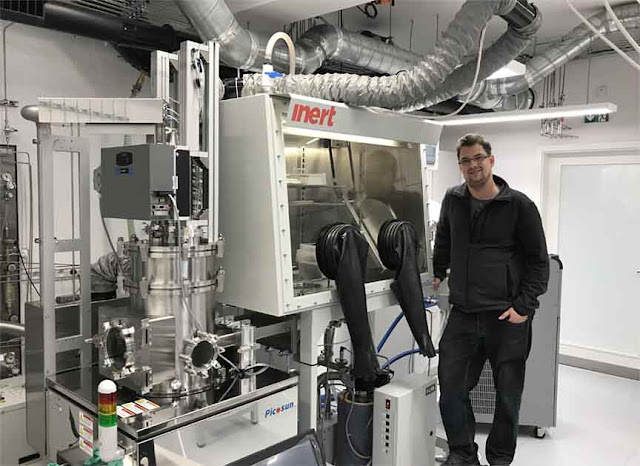Atomic Level Processing on top in Most Read JVST A Articles in 2017, including the Virtual Project on the History of ALD (VPHA) recommended reading list. A lot of Etch papers, and many of them from Lam Research.
Review
Article: Recommended reading list of early publications on atomic layer
deposition — Outcome of the “Virtual Project on the History of ALD”
Esko Ahvenniemi, Andrew R. Akbashev,
Saima Ali, Mikhael Bechelany, Maria Berdova, Stefan Boyadjiev, David C.
Cameron, Rong Chen, Mikhail Chubarov, Veronique Cremers, Anjana Devi,
Viktor Drozd, Liliya Elnikova, Gloria Gottardi, Kestutis Grigoras,
Dennis M. Hausmann, Cheol Seong Hwang, Shih-Hui Jen, Tanja Kallio, Jaana Kanervo, Ivan Khmelnitskiy, Do Han Kim, Lev Klibanov, Yury Koshtyal, A. Outi I. Krause, Jakob Kuhs, Irina Kärkkänen, Marja-Leena Kääriäinen, Tommi Kääriäinen, Luca Lamagna, Adam A. Łapicki, Markku Leskelä, Harri Lipsanen, Jussi Lyytinen, Anatoly Malkov, Anatoly Malygin,
Abdelkader Mennad, Christian Militzer, Jyrki Molarius, Małgorzata Norek,
Çağla Özgit-Akgün, Mikhail Panov, Henrik Pedersen, Fabien Piallat,
Georgi Popov, Riikka L. Puurunen, Geert Rampelberg, Robin H. A. Ras,
Erwan Rauwel, Fred Roozeboom, Timo Sajavaara,
Hossein Salami, Hele Savin, Nathanaelle Schneider, Thomas E. Seidel,
Jonas Sundqvist, Dmitry B. Suyatin, Tobias Törndahl, J. Ruud van Ommen,
Claudia Wiemer, Oili M. E. Ylivaara, Oksana Yurkevich
JVST A 35, 010801 (2017) |
Read More
Predicting synergy in atomic layer etching
Keren J. Kanarik, Samantha Tan, Wenbing Yang, Taeseung Kim, Thorsten Lill, Alexander Kabansky, Eric A. Hudson, Tomihito Ohba, Kazuo Nojiri, Jengyi Yu, Rich Wise, Ivan L. Berry, Yang Pan, Jeffrey Marks, Richard A. Gottscho
JVST A 35, 05C302 (2017) |
Read More
Role of neutral transport in aspect ratio dependent plasma etching of three-dimensional features
Chad M. Huard, Yiting Zhang, Saravanapriyan Sriraman, Alex Paterson, Mark J. Kushner
JVST A 35, 05C301 (2017) |
Read More
Atomic layer etching in close-to-conventional plasma etch tools
Andy Goodyear and Mike Cooke
JVST A 35, 01A105 (2017) |
Read More
Quasi-atomic layer etching of silicon nitride
Sonam D. Sherpa and Alok Ranjan
JVST A 35, 01A102 (2017) |
Read More
Atomic layer etching of SiO
2
by alternating an O
2
plasma with
fluorocarbon film deposition
Takayoshi Tsutsumi, Hiroki Kondo, Masaru Hori, Masaru Zaitsu, Akiko Kobayashi, Toshihisa Nozawa, Nobuyoshi Kobayashi
JVST A 35, 01A103 (2017) |
Read More
Atomic layer etching of 3D structures in silicon: Self-limiting and nonideal reactions
Chad M. Huard, Yiting Zhang, Saravanapriyan Sriraman, Alex Paterson, Keren J. Kanarik, Mark J. Kushner
JVST A 35, 031306 (2017) |
Read More
Review Article: Reactions of fluorine atoms with silicon, revisited, again
Vincent M. Donnelly
JVST A 35, 05C202 (2017) |
Read More
Correcting defects in area selective molecular layer deposition
Richard G. Closser, David S. Bergsman, Luis Ruelas, Fatemeh Sadat Minaye Hashemi, Stacey F. Bent
JVST A 35, 031509 (2017) |
Read More
Investigation of feature orientation and consequences of ion tilting during plasma etching with a three-dimensional feature profile simulator
Yiting Zhang, Chad Huard, Saravanapriyan Sriraman, Jun Belen, Alex Paterson, Mark J. Kushner
JVST A 35, 021303 (2017) |
Read More



%20(1).png)














